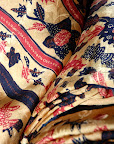Senin, 19 Juli 2010
History Batik Minangkabau
Minangkabau is called batik batik liek land, because of batik was originally from West Sumatra is one of The color liek soil, ie clay. There are a variety of other sources of natural dyes. There are leather jengkol, rambutan skin, gambier, mahogany skin, leaves jerame and many other roots are also used.
Batik Land Liek historically originated in China brought by Chinese traders. Because the beauty of Minang women to take advantage of this batik shawl. The price is relatively expensive and only used on special occasions only. In the event that was only used by ninik mamak and BUNDO KANDUANG, or custom models. This shawl is always maintained by the Minang people as relics of ancestral craft.
If the adoption of many other local batik motifs of flora, soil batik inspired liek Pessel lot of sea animals like sea horses, and other biota. It is said Chairman Mrs Dekranasda Pessel Nasrul abit journalist caused the topography of the area which lies on the coast so that its people are very familiar and close to the sea. So that marine life is diverse and has its own beauty becomes an inspiration to create works of art or handicrafts such as batik.
"There Pessel Batik motifs 9, 6 sea motif and a floral motif, namely kaluak nails to the edge of the fabric," said the hard-working journalist who raised the potential of this region to the outside world was accompanied by administrators Dekranasda, Syriac. History of batik originated Pessel liek cooking since ancient times, when the form of batik scarf worn only for customary events. Batik colors there are only two, the ground color and black.
Land of color obtained by soaking a cloth in a solution of clay. While black leather jengkol obtained from solution by immersing in water. Along the development of times, and tuntuan market, batik liek Pessel cooking developed into a variety of fashion such as clothes Stelan, clothing robe, head scarf and a shirt or dress koko for men. Any color according to taste increasingly diverse marketplace.
There are bright colors, like red, pink, blue, green colors to blend soft and beautiful colors. Basic silk fabric is not only lightweight and comfortable but there was also santung dobbies and others. Till now the land batik liek Pessel already flying everywhere, both in domestic and foreign.
Source : http://aku-cinta-batik.blogspot.com
Minggu, 18 Juli 2010
History Batik Cirebon
Cirebon batik production centers located in the village allegedly Trusmi Plered Cirebon Cirebon City is out as far as 4 km to the west or toward the direction of Bandung. In the village and surrounding Trusmi there are more than 1000 workers or craftsmen batik. Batik workforce comes from several areas around the village Trusmi, such as from the village Gamel, Kaliwulu, Wotgali and Kalitengah.
In general, Cirebon batik including batik into coastal groups, but also some batik Cirebon batik palace belongs to the class. This is because having two Cirebon Kraton Kraton is Keratonan Kasepuhan and Kanoman, supposedly based on the history of these two royal palace appeared several Cirebonan Classical batik design, which until now is still done by some rural communities such as motive Mega Trusmi Unisex, Paksinaga Liman, Patran Keris , Patran Kangkung, Lion Umbrella, Singa Barong, Banjar Balong, Chicken Base, plane bride, Katewono, Mount Giwur, Simbar Menjangan, Simbar Kendo and others.
Some important things that can become a feature or characteristic that is also owned by batik Cirebon is as follows:
batik a.Desain Cirebonan nuanced traditional classical in general always involves wadasan motif (rock) on parts of a particular motive. In addition there is also a cloud-shaped decorative element (mega) on the parts that are adjusted with its main motif.
b.Batik Cirebonan traditional classics have always been characterized by the color of the background (base fabric) younger than the color line on main motive.
c.Bagian background or base fabric is usually clean look of black stains or colors that are not desired in the manufacturing process. Black stain and can be caused by the use of batik wax break, so the process of dye staining is not desired permeate the fabric.
d.Garis-line Cirebonan batik motifs on the use of single lines and thin (small) approximately 0.5 mm with an older line of color compared with the background color. This is because the process of batik Cirebon superior in closing (blocking area) using a special canting to make the process of closure, that is using and bleber canting wall (made of bamboo sticks on the edges given a piece of cotton yarn thick and placed on one end of bamboo poles).
e.Warna-dominant color batik traditional classical Cirebonan usually have a yellow color (Sogan pads), the basic colors of black and beige, or dark red, navy blue, basic black with a cream color or ivory fabric.
f.Batik Cirebonan tend to choose some of the background fabric is left empty without filled with decorative shaped tanahan or rentesan (ganggeng plant-shaped ornament). Decorative shapes or rentesan tanahan is usually used by batik-batik from Pekalongan.
Still with batik Cirebonan, but have different characteristics with the previous group Cirebonan coastal batik. Batik Cirebonan coastal strongly influenced by the character of coastal communities which generally have a soul open and receptive to foreign cultural influences. Developments at the present time, which is owned by staining Cirebonan more colorful batik and uses elements of the lighter colors and brighter, and has a decorative shape which is free to combine elements of animals and other forms of visual diverse flora.
In a region with many foreigners sekitarpelabuhan usually transiting, anchored to happen different ethnic marriages (assimilation), the coastal batik Cirebonan more likely to receive from outside cultural influences brought by immigrants. Cirebon batik so this one is more likely to be able to meet or follow consumer tastes from various regions (more to the fulfillment of commodity trade and komersialitas), making the colors more attractive coastal batik Cirebonan using many colors. Cirebonan batik production at present consists of Batik Tulis, Cap and batik batik stamp stationery combination. In the year 1990 - 2000 there are some communities Cirebonan batik artisans who produce batik cloth Cirebonan screen printing technique with hand (hand printing), but lately the hand silk-screening technique is almost extinct, due to the silk-screening techniques can not compete with machines that are owned by companies more large. Trusmi batik growth appears to move quickly beginning in 2000, it can be seen from the emerging batik showroom showrooms around the main village road and Panembahan Trusmi. Batik showroom owner Trusmi almost entirely owned by the original Trusmi community although there are one or two are owned by the owners of capital from outside Trusmi.
Sample Collection Batik Cirebonan:
Batik Komar Motif Ganggengan
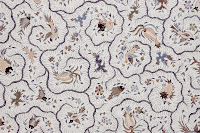
Batik Komar Motif Singa Payung

Batik Mega Mendung

Batik Wilejeung Rawuh
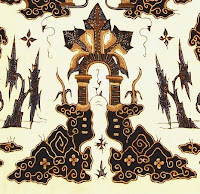
Source : http://www.netsains.com
In general, Cirebon batik including batik into coastal groups, but also some batik Cirebon batik palace belongs to the class. This is because having two Cirebon Kraton Kraton is Keratonan Kasepuhan and Kanoman, supposedly based on the history of these two royal palace appeared several Cirebonan Classical batik design, which until now is still done by some rural communities such as motive Mega Trusmi Unisex, Paksinaga Liman, Patran Keris , Patran Kangkung, Lion Umbrella, Singa Barong, Banjar Balong, Chicken Base, plane bride, Katewono, Mount Giwur, Simbar Menjangan, Simbar Kendo and others.
Some important things that can become a feature or characteristic that is also owned by batik Cirebon is as follows:
batik a.Desain Cirebonan nuanced traditional classical in general always involves wadasan motif (rock) on parts of a particular motive. In addition there is also a cloud-shaped decorative element (mega) on the parts that are adjusted with its main motif.
b.Batik Cirebonan traditional classics have always been characterized by the color of the background (base fabric) younger than the color line on main motive.
c.Bagian background or base fabric is usually clean look of black stains or colors that are not desired in the manufacturing process. Black stain and can be caused by the use of batik wax break, so the process of dye staining is not desired permeate the fabric.
d.Garis-line Cirebonan batik motifs on the use of single lines and thin (small) approximately 0.5 mm with an older line of color compared with the background color. This is because the process of batik Cirebon superior in closing (blocking area) using a special canting to make the process of closure, that is using and bleber canting wall (made of bamboo sticks on the edges given a piece of cotton yarn thick and placed on one end of bamboo poles).
e.Warna-dominant color batik traditional classical Cirebonan usually have a yellow color (Sogan pads), the basic colors of black and beige, or dark red, navy blue, basic black with a cream color or ivory fabric.
f.Batik Cirebonan tend to choose some of the background fabric is left empty without filled with decorative shaped tanahan or rentesan (ganggeng plant-shaped ornament). Decorative shapes or rentesan tanahan is usually used by batik-batik from Pekalongan.
Still with batik Cirebonan, but have different characteristics with the previous group Cirebonan coastal batik. Batik Cirebonan coastal strongly influenced by the character of coastal communities which generally have a soul open and receptive to foreign cultural influences. Developments at the present time, which is owned by staining Cirebonan more colorful batik and uses elements of the lighter colors and brighter, and has a decorative shape which is free to combine elements of animals and other forms of visual diverse flora.
In a region with many foreigners sekitarpelabuhan usually transiting, anchored to happen different ethnic marriages (assimilation), the coastal batik Cirebonan more likely to receive from outside cultural influences brought by immigrants. Cirebon batik so this one is more likely to be able to meet or follow consumer tastes from various regions (more to the fulfillment of commodity trade and komersialitas), making the colors more attractive coastal batik Cirebonan using many colors. Cirebonan batik production at present consists of Batik Tulis, Cap and batik batik stamp stationery combination. In the year 1990 - 2000 there are some communities Cirebonan batik artisans who produce batik cloth Cirebonan screen printing technique with hand (hand printing), but lately the hand silk-screening technique is almost extinct, due to the silk-screening techniques can not compete with machines that are owned by companies more large. Trusmi batik growth appears to move quickly beginning in 2000, it can be seen from the emerging batik showroom showrooms around the main village road and Panembahan Trusmi. Batik showroom owner Trusmi almost entirely owned by the original Trusmi community although there are one or two are owned by the owners of capital from outside Trusmi.
Sample Collection Batik Cirebonan:
Batik Komar Motif Ganggengan

Batik Komar Motif Singa Payung

Batik Mega Mendung

Batik Wilejeung Rawuh

Source : http://www.netsains.com
History Batik Madura

As a cultural art forms, batik Madura highly sought after and loved by local and long distance customers. With unique shapes and motifs Madura batik has its uniqueness to the consumer. The style and variety of unique and free, personalized nature of the production (done by unit), still maintain traditional ways (written and processed by traditional means) and always use natural dyes are environmentally friendly.
History records Madura batik producers and herbal medicine is quite popular. What made him become like that, perhaps because the two commodities is an integral part of the tradition of their own community.
Small industry which became the pride of this region's batik. For Madura, not just a piece of batik cloth, but has become a cultural icon and a frequent object of research in many institutions. In the various books published abroad batik, Batik Madura is of particular concern. Motifs and colors contained in a long cloth that reflects the character of the society. Tanjung Bumi Batik particularly artificial in Bangkalan.
Not only in the Cape of Earth only, batik has become the value of Indonesian arts and culture in foreign currency. Even the clothes batik clothes or be part of formal wear in Indonesia. Not infrequently we find or even often, by invitation, officials wear batik on formal occasions the family, country and others.
In essence, Batik with different shapes and styles, whether it Madurese batik, batik pekalongan, java batik, batik jogja, solo batik batik-batik and other areas of high culture is a work of art that need to be maintained, preserved, developed nation to become a valuable asset This international eyes.
Let us imagine what if the dress suit that is now the official state clothing across the world, replaced with Madura batik or batik from Indonesia? This truly is a thing that might happen if we could develop the Madura batik or batik Indonesia professionally. Hopefully.
Source : http://1001-madura.com
History Batik Pekalongan
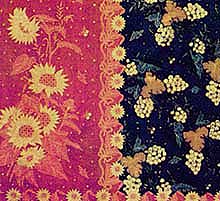
Although no official records began to be known when the batik in Pekalongan, but according to estimates existing in Pekalongan batik around the year 1800. Even according to the data recorded at the Ministry, batik was made in 1802, as a small tree motif in the form of dress material.
But significant progress is expected to occur after a major war in 1825-1830 in the kingdom of Mataram, called Java Diponegoro war or war. With the onset of this battle royal family and urged his followers to leave many areas of the kingdom. They then spread towards the East and West. Later in the area - a new area that the family and followers develop batik.
To the east of Solo and Yogyakarta batik batik refine the existing pattern in Mojokerto and Tulungagung to spread to Gresik, Surabaya and Madura. Medium West toward developing batik in Banyumas, Kebumen, Tegal, Cirebon and Pekalongan. With this migration, the existing Pekalongan batik previously flourished.
Over time, Batik Pekalongan experienced rapid growth compared with other regions. In this region, batik grew around coastal areas, namely in the regions and regional town of Pekalongan Buaran, Pekajangan and Wonopringgo.
Cultural development of printing techniques using dye motifs closing night (candles) on the fabric which was then called batik, is inseparable from the influence of those countries. This shows the resiliency of batik context of the times.
Pekalongan batik is very unique because it rested entirely on hundreds of small entrepreneurs, rather than on a handful of large employers have capital. Since many decades ago until now, most of Pekalongan batik production process is done in homes. As a result, closely united with batik Pekalongan Pekalongan community life which is now divided into two administrative regions, namely Pekalongan Municipality and Regency of Pekalongan.
Pekalongan batik tidal development, show worthy of Pekalongan batik an icon for the developments in the archipelago. Icon for works of art that never surrendered to the development of times and always dynamic. Now batik has become a breath of everyday life Pekalongan residents and is one of key products. This is because many industries which produce batik. Because the product is known for his batik, known as CITY BATIK Pekalongan. The nickname came from a long tradition rooted in Pekalongan. During that long period, various properties, the variety of uses, type design, as well as batik quality is determined by the climate and the presence of fibers of local, historical factors, trade and the readiness of communities to understand and accept new ideas.
Batik is an art culture that admired the world, among the traditional varieties produced with dye technology hurdles, none of which can be present as beautiful and as smooth as Pekalongan batik.
Source : http://aku-cinta-batik.blogspot.com
Jumat, 16 Juli 2010
History Motif Batik SOLO
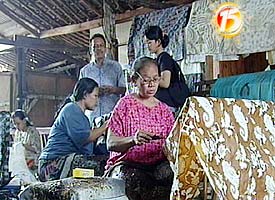
Kampung Batik Laweyan
Laweyan is one of the central Batik in Solo. Obviously this ward there are a lot of history left in this and an icon kapung Batik Solo
The history of batik in Indonesia is closely linked with the development and dissemination of the Majapahit empire of Islam in Java. In some records, the development of batik is mostly done in times of Mataram Kingdom, then on the work of Solo and Yogyakarta.
So the art of batik in Indonesia has been known since the days of work and growing to the Majapahit kingdom and the kings of the next. As for starting the spread of this batik art belongs to the people of Indonesia and Java in particular tribe is after the end of the century or the beginning of XVIII-XIX century. Produced batik batik is all until the early twentieth century and printed batik is known only after the world wars or the unity out around 1920. The connection with the spread of Islamic teachings. Many areas in Java batik centers are areas Batik students and then become a tool of economic perjaungan by figures pedangan Muslims against the Dutch economy.
Batik art is the art of drawing on the fabric for clothing that becomes one of cultural keluaga Indonesian kings of old. Batik initially worked in the palace just limited to clothing and the result was the king and family and his followers. Because many of the followers of the king who lived outside the palace, the art of batik was brought by the palace and carried them out in place of each.
Long batik art was imitated by the people nearest and subsequently expanded into the work of women in the household to fill his spare time. Furthermore, batik clothing was only the royal family, then became a popular folk clothes, both women and men. White fabric that is used when it is the result of homespun.
Medium coloring materials used consist of plants native to Indonesia who made their own from among others: noni tree, tall, soga, indigo, and materials made from soda ash soda, as well as salts made from tanahlumpur.
Jaman Majapahit
Batik has become the kingdom Majahit culture, can be traced in Mojokerto and Tulung Court. Mojoketo are areas closely related to the Majapahit kingdom during the first and the origin of the name have anything to do with Majapahit Majokerto. Relation to the development of batik developed in Tulung Majapahit Agung is the history of batik developments in this area, can be extracted from the relic in the age of the Majapahit kingdom. At that time the area is partly composed of Tulungagung swamps in the history of the area known as Bonorowo, which at the time of Majapahit bekembangnya area controlled by a Duke benama Kalang, and did not surrender to the kingdom of Majapahit.
Told that the police actions waged by Majapahati, Duke Kalang allegedly killed in the fighting around the village which is now reportedly named Kalangbret. Thus, the officers and soldiers who settled keluara Majapahit kingdom and lived in the territory which is now named Bonorowo or Tulungagung among others also bring original art to make batik.
Batik is now in the Mojokerto region contained in Kwali, Mojosari, Betero and Sidomulyo. Outside the Mojokerto regency is in Jombang. At the end of XIX century there were several people known batik in Mojokerto, the materials used at that time white cloth woven by himself and drugs from soga jambal batik, noni, indigo tom, height and so forth.
Drugs known abroad the new postwar world of unity which are sold by Chinese traders in Mojokerto. Batik is known along with the entry of drugs from abroad batik. Cap made in Bangil and entrepreneurs can buy batik Mojokerto Porong market in Sidoarjo, this Porong Market before the world economic crisis known as the bustling market, where the results of production and Jetis Sidoarjo batik Kedungcangkring lot sale. Time of economic crisis, batik entrepreneurs participate Mojoketo paralyzed, because most small entrepreneurs business. Batik events arising after the crisis go back to Japan's entry into Indonesia, and the time the Japanese occupation of batik activities paralyzed again. Batik activity appears again after the revolution which has become a regional Mojokerto occupation.
A typical characteristic of batik Kalangbret of Mojokerto is almost equal to the output of batik-batik of Yogyakarta, which is basically white and brown 's type and color of dark blue. Known since more than a century ago the village of batik Majan and Simo. The village also has a history as a relic from the war era Prince Diponegoro in 1825.
Although batik is known since antiquity Majapahait but batik development began to spread rapidly since the region of Surakarta, Central Java and Yogyakarta, at the time of the kingdom in this region. It appears that the development of batik in Mojokerto and more dipenagruhi Tulung next Supreme Solo and Yogyakarta batik patterns.
In berkecamuknya clash between the Dutch colonial army with the troops of Prince Diponegoro, then some of the Kyai Mojo troops withdrew towards the east and until now the Majan. Since the Dutch colonial period until the time of independence is the status of rural villages Merdikan Majan (Special Region), and the village head of a chaplain whose status-temurun.Pembuatan Uirun Majan batik is an instinct (relic) of the art of making batik Diponegoro war era.
Color babaran Majan and Simo batik is unique because of the color red babarannya lit (from mulberry bark) and other colors of the tom. As a batik Setra since time immemorial village area is also famous Sembung, which batik entrepreneurs mostly from Tulungagung Sala coming in at the end of XIX century. Only now there are still some families who settled batik from Sala Sembung area. Apart from the proficiency level in these places there are also areas of batik in Psychology and also a couple in Kediri, but the nature of some of the batik craft and household babarannya batik.
The spread of the Islamic era
History of batik in other areas of East Java is in Ponorogo, whose story is related to the spread of Islam in this region. History of Batik. Mentioned problem areas Ponorogo batik art are closely related to the development of Islamic religion and the kingdoms first. It is said Batoro Katong area, there is a direct descendant of the Majapahit empire named Raden Raden Patah sister of Katong. Katong Batoro this is what brought Islam to the existing ruins Ponorogo and now is a mosque Patihan Wetan area.
Selanjutanya developments, in Ponorogo, Tegalsari area there is a boarding school that nurtured Kyai Hasan Basri or known as the Great Tegalsari Kyai. This Tegalsari pesantren teach religion other than Islam also teaches administrative sciences, sciences and literature of war. A disciple of the famous from the literary field is Tegalsari Ronggowarsito Raden. Kyai Hasan Basri was taken into law by the king Kraton of Solo.
Batik art at that time was limited within the palace. Therefore Solo palace princess became the wife of Kyai Hasan Basri Tegalsari and then brought into-accompaniment followed by a retinue. besides that many of the royal family also learned dipesantren Solo this. These events bring art out of the palace bafik toward Ponorogo. Young people educated in this Tegalsari when it came out, the community would donate his batik dharma in areas kepamongan and religion.
Long batik areas that we can see now is a region that is Kepatihan Wetan Kauman now and from here spread to the villages Ronowijoyo, Mangunsuman, Kertosari, Setono, Cokromenggalan, Duchy, Nologaten, Bangunsari, Cekok, Banyudono and Ngunut. It was the drugs used in batik are made in our own country from woody among others; tom tree, noni, tall timber. While homemade kainputihnyajugamemakai materials from woven carrying. Bam imported white cloth known in Indonesia about the late-19th century.
Batik-making in the new Ponorogo known after the first world war brought on by a Chinaman named Kwee Seng from Banyumas. Ponorogo region early 20th century in the famous batik indigo dye that does not fade and that's why entrepreneurs Banyumas and Solo batik from giving jobs to many entrepreneurs in Ponorogo batik. As a result of the familiar printed batik production petama Ponorogo after World War until the outbreak of the second world war that is famous for his rough batik batik blue mori. Market batik rough Ponorogo then famous throughout Indonesia.
Solo and Yogyakarta Batik
From work-in Solo and Yogyakarta royal surroundings and 19th century, 17.18, batik and widespread, particularly in the area of Java Island. Batik was originally just a hobby of the royal family in the past decorated clothing. But subsequent developments, pleh society developed into a commodity perdagamgan batik.
Solo Batik is famous for its traditional batik patterns and patterns in the process of batik cap or she writes. The materials used for staining still remains a lot of use of domestic materials such as Java soga already known from the first. Fixed pattern, among others, famous for its "Sidomukti" and "Sidoluruh".
While the origins of batik area since the kingdom of Mataram Yogyakarta is known to any-I with a Panembahan Senopati raj. First is the village of batik Region Plered. Batik at the time limited in the royal family environment which was done by the women helpers queen. From here batik work extends to the first trap on the other the wife of the royal family from the servants in the palace and the soldiers. At the official ceremony of the royal family palace both men and women wearing clothes with batik and striated kombonasi. Therefore, this kingdom received a visit from the people and the people interested in the clothes worn by the royal family and imitated by the people and finally meluaslah batik out of the palace walls.
As a result of good old time of war between the families of kings as well as between the Dutch colonial past, so many families of the king who fled and settled areas of new areas, among others, to Banyumas, Pekalongan, and Eastern regions of Ponorogo, Tulungagung and sebagainy a. Meluasny a local batik-stricken area until that area according to the historical development of Indonesian struggle beginning of the 18th century. Families who fled the palace is that developed all over the island of Java, batik work of the existing and developing new areas of nature and according to it.
Diponegoro's war against the Netherlands, urged the prince and his family and his followers have left the kingdom. They then spread towards the East and West. Then in the new areas that the family and followers of Prince Diponegoro to develop batik.
East to Solo and Yogyakarta batik batik improve the existing pattern in Mojokerto and Tulung Court. It also spread to Gresik, Surabaya and Madura. Medium westward batik developed in Banyumas, Pekalongan, Tegal, Cirebon.
Batik developments in other Cities
The development of batik in Banyumas Sokaraja centered in the area brought by the followers of Prince Diponegero after wide-inya war in 1830, their most-ap menet Banyumas region. Followers of the famous time was Najendra and he developed a dye batik in Sokaraja. Materials used mori homespun results and medications used pewama tom trees, mulberry trees and the pace that gives the red color of yellow artificiality.
Long batik gradually spread to the people Sokaraja and at the end of XIX century are directly related to region Solo batik and Ponorogo. Areas in Banyumas batik had been known since before the motif and color in particular and is now called batik Banyumas. After world war unity of batik is also done by the Chinese began their trade as well as batik material. .
Similar to batik in Pekalongan. The followers of Prince Diponegoro, who settled in this area and then develop sekitara batik business in this coastal area, namely in areas other than their own Pekalongan, batik is growing rapidly in Buawaran, Pekajangan and Wonopringgo. The presence of batik in these areas almost simultaneously with other regions of batik which is about the nineteenth century. Batik-development areas outside the region apart from Yogyakarta and Solo are closely related to the development history of the kingdom of Yogyakarta and Solo.
Widespread batik out of the palace after the end of the Diponegoro war and the many regions of the royal family who had moved out of areas because of Yogyakarta and Solo would not kejasama with the colonial government. The royal family took their followers that new regions and places of batik was continued and then became a job for livelihood.
Batik pattern in this new area is also adapted to the circumstances surrounding areas. Especially seen from the Pekalongan and designya much influenced by the batik of Demak. Until the early twentieth century is the process known as batik batik morinya with domestically produced materials and some imported. After the world war a new unity known batik fabrication and use of foreign medicines made in German and English.
In the early 20th century was first known in Pekajangan is producing weaving and yarn spinning Stagen itself is simple. In recent years new batik is known to be worked by people who work this weaving sector. Growth and more rapid development of weaving batik Stagen and never sugar mill workers in Wonopringgo and Tirto companies ran into batik, because wages are higher than the sugar factory.
Tegal batik was known in the late nineteenth century and that it used a homemade time taken from plants: pace / noni, indigo, soga wood and homespun fabric. Tegal batik was first color is babaran Sogan and gray after a known indigo plant, and then increased to a red-blue color. Tegal batik market when they came out among the other regions of West Java, was taken solely by entrepreneurs in their walk and this is according to the history of the development of batik in Tasik and-comer Ciamis besides other newcomers from the cities of Central Javanese batik.
In the early twentieth century was known mori import and import of new drugs known as post-war world unity. Batik entrepreneurs in Tegal mostly weak in capital and raw materials obtained from the Pekalongan and with credit and batik are sold in China provides loans to such materials. Time of economic crisis Tegal batik-batik participate actively re-flagging and new around the year 1934 until the beginning of the second world war. When the Japanese went dead again batik work activities.
Pila thus the history of batik in Purworejo along with batik in Kebumen is derived from Yogyakarta around XI century. Pekembangan batik in Purworejo than in Kebumen faster in Kebumen. Production as well as the Yogyakarta and other Banyumas areas.
While in the area Bayat, Klaten District Tembayat Kebumen-situated approximately 21 km east of the town of Klaten. Bayat region is located at the foot of the mountain village but the land is arid and minuses. These areas include environmental Surakarta and Klaten district and the history of batik here certainly closely related to the history of the former royal palace in Surakarta. Bayat Village is now no ruins can be visited by people in certain times of "grave of Sunan Bayat" on the mountain Jabarkat. So Bayat batik village has existed since the time of first job. Batik entrepreneurs in Bayat had most of the handicraft and batik workers in Solo.
While batik in Kebumen is known about the early nineteenth century, brought by immigrants, immigrants from the Islamic da'wah in order to Yogya, among others, which is known is this: PenghuluNusjaf. He is what develops in Kebumen batik and first place is settled east Lukolo time now and there are also relics of the mosque for his efforts. The first backward process in Kebumen called teng-brother or Blambangan and subsequently the final process is done in Banyumas / Solo. Around the early twentieth century to create a pattern which is used turmeric capnya made of wood. Kebumen motives were: the trees, bird-burungan. Other materials used are trees pace, tom kemudu and indigo.
The use of imported drugs in Kebumen is known around the year 1920 which was introduced by the employees of Bank Rakyat Indonesia, which finally left the homemade ingredients, as it saves time. Use of copper seal is known around the year 1930 brought by Purnomo of Yogyakarta. Areas is the village of batik in Kebumen: Watugarut, Tanurekso that much and there are several other villages.
Viewed with the relics are now, and the stories passed down through generations of the foregoing, it is predicted that Batik Tasikmalaya region known since the days of "Tarumanagara" which is a relic of the existing number of trees found there tarum useful for making batik time . Heritage village which still exists today it is the crude batik: batik craft Wurug famous, Sukapura, Mangunraja, Maronjaya and Tarlac City.
Formerly the center of government and bustle of the famous village is Sukapura, Indihiang the edge rows Tasikmalaya town now. Approximately end of the century and early XVII-XVIII century a result of the battle between kingdoms in Central Java, many of the local population: Tegal, Pekalongan, Ba-nyumas and Western regions of the Holy migrate and settle in Ciamis and Tasikmalaya. Most of them are batik entrepreneurs area and headed towards the West while the batik trade. With the advent of this new population, both wearing pembutan next dikenallah soga originally from Central Java. Tasikmalaya batik production now is a mixture of batik-batik Pekalongan, Tegal, Banyumas, Ghost of a diverse patterns and colors.
Batik was known in Ciamis about XIX century after the completion of the Diponegoro war, where followers of Diponegoro, many who left Yogyakarta, heading south. Some regions have settled there Banyumas and some who continued the journey to the south and settled in Ciamis and Tasikmalaya now. They migrate with keluargany a new place and settle into the population and continue to live and work procedures. Some of them were experts in the craft of batik as household work for women. Eventually, this work could be developed on the surrounding residents due to the daily interactions or family relationship. The materials used for self-woven fabric and paint materials made from trees such as mulberry, tom tree, and so forth.
Batik Ciamis result is a blend of Central Javanese batik and their own regional influence, especially Garutan motifs and colors. Until the early twentieth century batik in Ciamis growing little by little, from their own needs into the production market. 're In the area of Cirebon batik there kaintannya with the kingdom in this aerah, namely Kanoman, Kasepuahn and Keprabonan. The main source of batik Cirebon, the case is the same as those in Yogyakarta and Solo. Batik environment appears palace, and taken out by servants in the palace who reside outside the palace. Ancient kings delighted with the paintings and prior known cotton yarn, the painting was placed on palm leaves. It happened around the XIII century. It has something to do with batik motifs on the fabrics. Characteristic of batik Cirebonan a large part motivated images of forests and wildlife symbol. While the sea motif because the nature of thought influenced by China, which the sultanate of Cirebon editing the first ever Chinese princess. Sementra Cirebonan batik depicts a eagle as influenced by Yogya and Solo batik motifs.
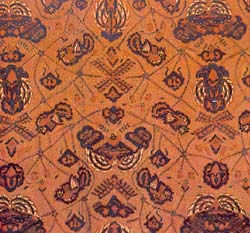
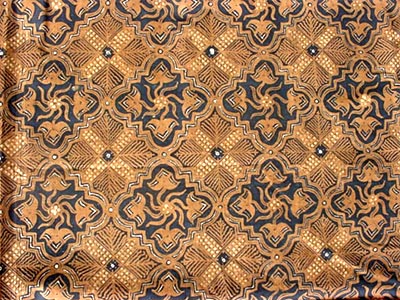

Motif Batik art value Megamendung

Megamendung motifs used by the community as a basic motive Cirebon batik already familiar to the people of Indonesia batik lovers, nor for society batik lovers abroad. Evidence of motive Megamendung fame comes from the city of Cirebon never be used as the cover of a book published abroad batik Batik Design work entitled Pepin Van Roojen Dutch nation.
History of the emergence of motifs adopted by the community Megamendung Cirebon taken from various books and literary history always lead to the arrival of China who came to the region of Cirebon. Clearly recorded in history that Sunan Gunungjati married Queen Ong Tien from China. Some art objects brought from China, such as ceramics, dishes, fabric Decorated with clouds form. Aan shape symbolizes the world in a variety of cultures over ideology when taken from Taoism. Cloud forms a broad picture of the world, free and has a meaning transidental (Divinity). The concept of this cloud was also influential in the artistic world of Islam in the 16th century used by the Sufis for the expression of major world or nature.
Basic values in Megamendung
The fundamental values in any art including batik motifs in art can be approached in a way Megamendung as follows:
a. Value of appearance (appearance) or values that gave birth to a form of art objects. This value consists of the value of the shape and structure of values. Value of a form that can be seen visually is the motive Megamendung in a beautiful fabric apart from the use of materials such as cotton or silk cloth. While the value of the structure is generated from the forms which are prepared in such a way based on essential values. The shapes of curved lines arranged irregularly and are not interrupted each other.
b. Value Content (Content) which can consist of the value of knowledge (cognition), the value of feeling, intuition or the unconscious man, the value of ideas, and the value of the message or the value of life (values) that can consist of the moral, social values, religious values, etc. .
In Megamendung form we can see the irregular curved lines on a regular basis from most forms of curved lines in the (smaller) and then widen out (enlarged) shows the regular harmonic motion. You could say that the line of irregular arches are bringing a message of moral in human life is always changing (going up and down) kemudian untuk evolved out search of their identities (study / social life through religion) and to finally bring dirinya into a new world into a union of self menuju kembali after going through ups and downs (ups and downs) finally returned to its origin (sunnatullah). So that we can see form Megamendung always formed from the small arches that move increases keep coming out and eventually had to go back again into small rounds but should not be interrupted. Apart from the meaning of the philosophy that symbolizes Megamendung intact human life must be aligned so that its form. Viewed in terms of production do require that if the form of curved lines Megamendung must meet at one point so that the next bend on the date when the color on a gradual process (from the color of the young to the old colors) could be easier.
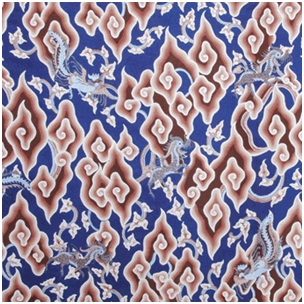
When we look at, then we will get that form Megamendung lot of variations. There is shaped taper at the ends and there is a round blunt at the tip. There also have angular-shaped indentation in the form of curve. Batik designer itself for beginners who are unfamiliar with the process of making batik and do not understand the meaning of philosophy Megamendung, when drawing Megamendung be little difficulty and possible errors will occur. That must be considered again is almost similar to the motif Megamendung Wadasan motive. But not the same as its placement with Wadasan motive (need to be focused on the next occasion).
c. Value Disclosure (presentation) that can show the existence of the value of one's personal talents, skills values, and the value of the medium he uses. Expression displayed by the artist in the form of a beautiful batik process by providing a scratch through the wax-called canting tool made of thin copper material formed carefully so that hot wax is past the end of canting can flow smoothly. Elements of a harmonious blend of color with meaningful for anyone who saw it. Blue elements that we know the color symbolizes the sky is so vast, friendly and calm. Augmented by some to mean that the blue color symbolizes fertility so that batik was originally Megamendung always gives a blue color elements are interspersed with the red primary color.
Batik world developments coupled with the growing demand for batik is so diverse, so many motives Megamendung modified with a variety of approaches, as follows:
1. Shape Motif
Megamendung motif forms at the present time has changed and modified in accordance with market demand among the community of fashion designers (fashion designer). Do not deny that the group of fashion designers who contributed to the advancement of the world is very big to lift motif batik including Megamendung. Megamendung motif was combined with motifs of animals, flowers or other motif elements. Indeed the existence of motives Megamendung combined with other motifs already exist from earlier times and was created by traditional batik artists. But lately after being taken in total by the fashion designer batik Megamendung growing rapidly.
2. Production Process
Megamendung batik production process which used to be done in batik and batik, now developed also with the production process of screen printing (print). Thus the production cost can be reduced more cheaply. Although Megamendung patterned fabric made with silk-screening process can not we call batik, but commercial motives Megamendung an easy target for textile manufacturers who can produce many benefits.
3. Production Forms
The realization of the object at the current production is no longer wearing Megamendung motif in the form of batik cloth. Megamendung motif used as wall decoration glass painting, the interior of carved wood products, those that are made as products pillowcases, bed linen, tablecloths (household) and others.
I agree and strongly supports the opinion of a group of lovers who make batik motifs Megamendung is a form of work that is very noble and meaningful, so the use of motives should be well guarded Megamendung and placed properly. We as a society engaged in the world does not limit how batik motifs form Megamendung produced, but I do not agree when the motives Megamendung with various forms of manufactured goods in the form of coatings used in hotels sandals.
Langganan:
Postingan (Atom)
